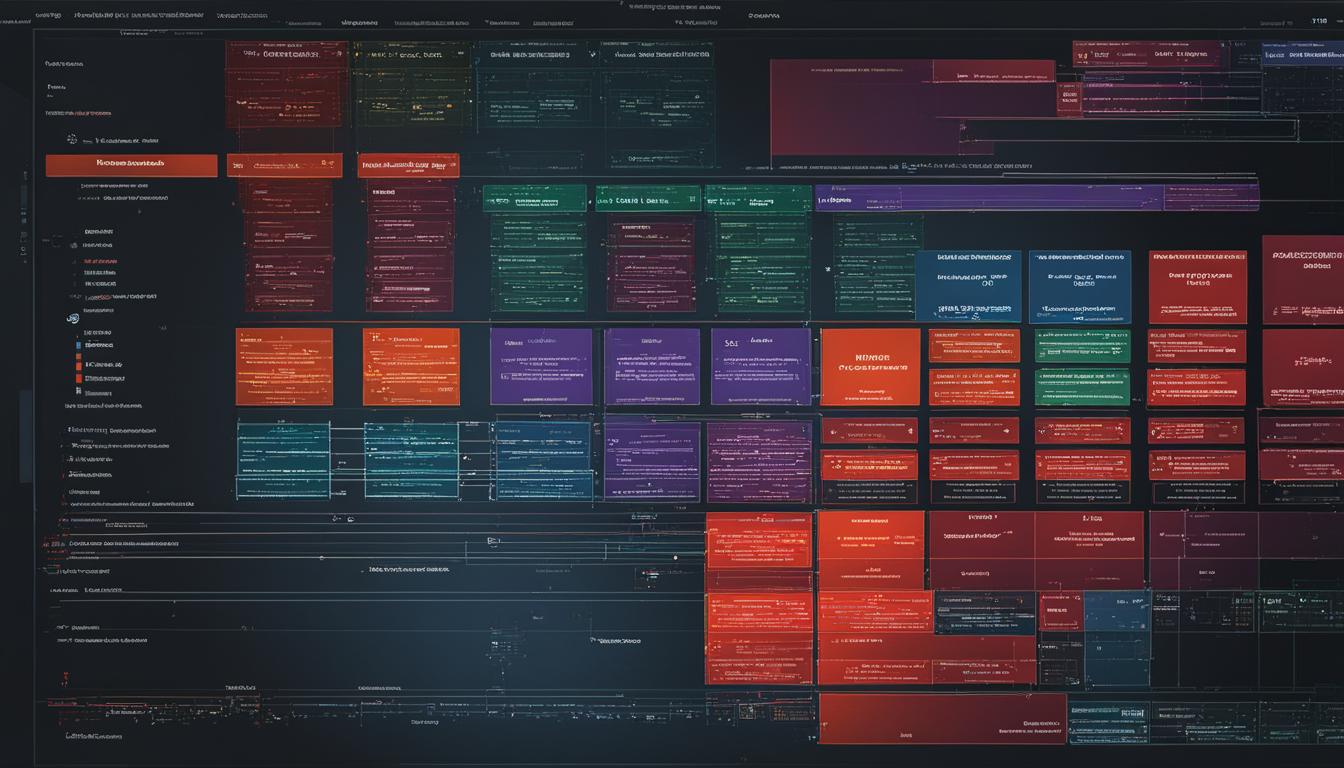Matrices play a crucial role in information technology (IT), offering a powerful framework for data representation and mathematical computations. In simple terms, a matrix is a rectangular grid of numbers that can be used to represent various types of data and equations. In the world of IT, matrices are widely employed in fields such as image processing, genetic analysis, graphics, and digital sound processing.
So, what exactly is a matrix in information technology? A matrix is a structured arrangement of numbers organized into rows and columns. It provides a concise representation of complex data and relationships between different variables. By utilizing matrices, IT professionals can efficiently perform calculations, solve systems of linear equations, and process data in a variety of applications.
Contents
- 1 Matrices in Linear Equations and Computations
- 2 Matrix Multiplication in Applications
- 3 Understanding Matrix Factorization
- 4 Practical Applications of Matrix Factorization
- 5 Benefits and Significance of Matrix Factorization
- 6 Conclusion
- 7 FAQ
- 7.1 What is a matrix in information technology?
- 7.2 What is the concept of a matrix in technology?
- 7.3 What is the matrix structure in information technology?
- 7.4 What is matrix multiplication in technology?
- 7.5 What are the benefits of using matrices in information technology?
- 7.6 What are the challenges of implementing a matrix structure in IT?
- 7.7 What is matrix factorization in information technology?
- 7.8 What are the practical applications of matrix factorization in IT?
- 7.9 How does matrix factorization work?
- 7.10 What are the benefits and significance of matrix factorization in data analysis?
- 8 Source Links
Key Takeaways:
- A matrix is a rectangular grid of numbers used for data representation and mathematical computations in IT.
- Matrices are essential in fields like image processing, genetic analysis, graphics, and digital sound processing.
- They enable efficient calculations, the solution of systems of linear equations, and advanced data processing.
- Matrices facilitate complex operations such as multiplication, filtering, compression, and graph analysis.
- Understanding matrices is crucial for professionals in IT, as they provide valuable insights and enhance technological capabilities.
Matrices in Linear Equations and Computations
Matrices play a pivotal role in linear equations and computations within the realm of information technology. In the context of linear equations, which involve variables without exponents and result in straight-line graphs, matrices provide a structured approach for representation and solving. With their ability to capture the coefficients of variables, matrices empower us to efficiently solve systems of linear equations, enabling the resolution of complex mathematical problems.
In the field of computer science, matrices find broader applications in various computations. Multiplication, filtering, compression, and graph analysis are just a few examples of the computational tasks that matrices facilitate. By leveraging the matrix structure, organizations can process data efficiently and extract meaningful insights from large datasets. Matrices form an integral part of the matrix organization in information technology, augmenting the effectiveness of matrix management systems that are prevalent in the industry.
When it comes to handling complex systems and datasets, matrices provide a structured framework that simplifies computations and enhances efficiency. Whether it’s solving linear equations or performing advanced data analysis, matrices in IT serve as the foundation for computational success.
The Power of Matrices in Linear Equations
Matrices serve as a concise representation of systems of linear equations, allowing us to organize and manipulate complex mathematical relationships efficiently. By arranging the coefficients of variables in a grid-like structure, matrix systems in technology enable the solution of linear equations through computational methods like Gaussian elimination or matrix inverses. This structured approach empowers organizations to handle intricate mathematical calculations with ease.
Matrices for Computational Tasks
Beyond their role in linear equations, matrices are instrumental in a variety of computational tasks within information technology. Consider the following applications:
- Multiplication: Matrices facilitate efficient and scalable multiplication operations, enabling the processing of large datasets and the transformation of data elements.
- Filtering: Through the use of matrix masks, organizations can apply filters to images, videos, or signals, extracting relevant information while minimizing noise or unwanted artifacts.
- Compression: Matrices play a crucial role in data compression techniques such as the discrete cosine transform (DCT) and singular value decomposition (SVD), enabling efficient storage and transmission of information.
- Graph Analysis: With matrices, network graphs can be represented and analyzed effectively, unlocking insights into connectivity patterns, centrality measures, and other graph properties.
By harnessing the power of matrices, organizations can optimize data processing, streamline computations, and unlock valuable information. The matrix system in technology acts as a fundamental building block for data-driven applications, contributing to the success of matrix management in IT.
| Application | Benefits |
|---|---|
| Multiplication | Efficient and scalable processing of large datasets |
| Filtering | Extraction of relevant information while minimizing noise |
| Compression | Efficient storage and transmission of data |
| Graph Analysis | Insights into connectivity patterns and graph properties |
Matrix Multiplication in Applications
Matrix multiplication plays a crucial role in various applications within the realm of information technology. Its capabilities extend to image processing, video decoding, digital sound filtering, and logistic problems in computer science. By multiplying matrices, you can match up rows and columns, multiply corresponding terms, and sum up the products. This operation enables us to predict weather patterns, analyze network diagrams, and solve systems of linear equations.
One of the key benefits of matrix multiplication in IT is its computational efficiency. Despite the challenges associated with creating useful matrices, this operation allows for advanced data processing and analysis. With the ability to represent complex relationships and perform intricate calculations, matrices empower information technology professionals to tackle large-scale problems and extract valuable insights from vast datasets.
For a deeper understanding of the benefits and challenges associated with matrix multiplication in information technology, consider the following:
“Matrix multiplication enables us to process and analyze complex data efficiently, supporting a wide range of applications in fields like image processing, video decoding, and logistics. It helps unravel hidden patterns, solve intricate problems, and uncover valuable insights.”
Benefits of Matrix Multiplication in IT
Matrix multiplication offers several advantages in information technology:
- Efficient data processing and analysis
- Accurate prediction of weather patterns and other complex systems
- Effective analysis of network diagrams
Challenges of Matrix Multiplication in IT
While matrix multiplication brings numerous benefits, it also presents challenges for IT professionals:
- Creating useful and properly structured matrices
- Efficient computation of large matrices
- Managing memory and storage requirements for matrix operations
Despite these challenges, matrix multiplication remains an essential tool in information technology, empowering professionals to leverage the full potential of data analysis and processing.

Understanding Matrix Factorization
Matrix factorization is a powerful mathematical technique utilized in the field of information technology. This technique allows for the decomposition of complex matrices into simpler components, enabling a deeper understanding of the underlying data. One common method of matrix factorization is the Singular Value Decomposition (SVD), which breaks down a matrix into its constituent parts.
The SVD process involves separating a matrix into three main components: left singular vectors, singular values, and right singular vectors. The left singular vectors represent the relationships between users and latent features, while the right singular vectors depict the connections between items and latent features. The singular values indicate the significance of each latent feature within the matrix.
Matrix factorization has practical applications across various domains in information technology. In recommendation systems, it plays a crucial role in predicting user preferences and suggesting relevant items. Image and data compression also benefit from matrix factorization, as it aids in reducing storage or bandwidth requirements while preserving essential information.
Collaborative filtering, another application of matrix factorization, leverages this technique to analyze user preferences and make automatic predictions. In the field of natural language processing (NLP), matrix factorization facilitates word embedding, allowing words to be represented in a continuous vector space for enhanced semantic analysis.
By utilizing matrix factorization, organizations can uncover hidden patterns within data, leading to more accurate predictions and efficient information processing. This technique enables a better understanding of complex datasets and empowers businesses to make informed decisions based on the extracted features.
Overall, matrix factorization is a versatile and valuable tool for information technology professionals, offering practical applications in recommendation systems, image and data compression, collaborative filtering, and natural language processing.
Practical Applications of Matrix Factorization
Matrix factorization finds extensive use in various practical applications, providing significant benefits to industries and organizations. Some notable applications include:
- Recommendation Systems: Matrix factorization enhances recommendation systems by predicting user preferences and improving recommendation accuracy.
- Image Compression: Matrix factorization techniques assist in reducing the storage requirements of image files without compromising essential details.
- Data Compression: Similar to image compression, matrix factorization plays a role in compressing large datasets, optimizing storage and transmission efficiency.
- Collaborative Filtering: By leveraging matrix factorization, collaborative filtering algorithms can make personalized recommendations based on user behavior and preferences.
- Natural Language Processing: Matrix factorization helps in tasks such as word embedding, where it represents words in vector space, enabling semantic analysis and measuring relationships between words.
The practical applications of matrix factorization emphasize its widespread usefulness in diverse technological domains. As organizations continue to rely on data-driven decision-making, understanding matrix factorization becomes increasingly vital in leveraging the power of complex data matrices.
Practical Applications of Matrix Factorization
Matrix factorization plays a crucial role in a wide range of technology applications. Let’s explore some practical applications where matrix factorization is utilized:
Recommendation Systems: Matrix factorization is extensively used in recommendation systems to accurately predict user preferences and recommend relevant items. By analyzing user behavior and patterns, matrix factorization enables personalized recommendations that enhance user experience and drive engagement.
Image Compression: Matrix factorization techniques are applied in image compression to reduce storage requirements while preserving essential information. By breaking down complex image data into simpler components, matrix factorization allows for efficient storage and transmission of images without significant quality loss.
Data Compression: Matrix factorization is also utilized in data compression to minimize bandwidth utilization. By representing high-dimensional datasets in a lower-dimensional form, matrix factorization enables efficient storage and transmission of data, making it ideal for applications with limited resources.
Collaborative Filtering: Collaborative filtering uses matrix factorization to analyze user preferences and make automatic predictions. This technique is commonly employed in recommendation systems, social networks, and online platforms to provide personalized suggestions, improve user engagement, and enhance the overall user experience.
Natural Language Processing (NLP): In the field of NLP, matrix factorization plays a vital role in tasks like word embedding. It helps represent words in a continuous vector space and determines semantic relationships between them. By capturing the semantic meaning of words, matrix factorization enables more accurate natural language understanding and processing.

| Matrix Component | Description |
|---|---|
| Left Singular Vectors | Represent relationships between users and latent features |
| Singular Values | Indicate the significance of each latent feature |
| Right Singular Vectors | Denote relationships between items and latent features |
Matrix factorization, with its ability to uncover hidden patterns, has wide-ranging applications in recommendation systems, image processing, data compression, and more. By understanding how it works and leveraging its capabilities, you can gain valuable insights from complex data and drive more informed decision-making.
Benefits and Significance of Matrix Factorization
Matrix factorization plays a crucial role in data analysis and processing, offering numerous benefits in various applications. By leveraging this technique, you can unlock hidden patterns within complex data sets, leading to more accurate predictions and recommendations in systems like collaborative filtering and recommendation engines.
One of the key advantages of matrix factorization is its ability to extract latent features from data, revealing underlying structures that may not be immediately apparent. This process of uncovering hidden patterns allows for a better understanding of relationships and paves the way for informed decision-making based on the extracted features.
Moreover, matrix factorization techniques, such as Singular Value Decomposition (SVD), contribute to efficient information processing. By compressing data while preserving essential information, matrix factorization enables streamlined storage and transmission of data, optimizing computational resources.
To illustrate the significance of matrix factorization, consider the example of a recommendation system. By utilizing matrix factorization, the system can analyze user preferences and extract latent features, enabling more accurate recommendations. This approach goes beyond simple demographic data, providing insights into individual preferences and patterns that might not be evident at first glance.
Matrix factorization’s ability to uncover hidden patterns and facilitate accurate predictions makes it invaluable in diverse fields, including finance, healthcare, e-commerce, and social media analysis. With its efficient information processing capabilities and the potential for improved decision-making, matrix factorization offers a powerful analytical tool for organizations aiming to extract the most value from their data.
Key Benefits of Matrix Factorization:
- Extraction of hidden patterns in data
- More accurate predictions and recommendations
- Efficient storage and transmission of information
- Optimized computational resources
- Enhanced decision-making based on extracted features
Example of Matrix Factorization in Recommendation Systems:
“Matrix factorization applied to recommendation systems enables personalized recommendations by capturing the nuanced preferences of individual users. By analyzing historical behavior and user-item interactions, matrix factorization effectively uncovers hidden features and patterns, resulting in highly accurate recommendations that align with each user’s unique tastes and preferences.”
– Name of Expert

| Benefits | Significance |
|---|---|
| Extraction of hidden patterns in data | Enables accurate predictions and recommendations |
| Efficient information processing | Optimizes computational resources and storage |
Conclusion
Matrix factorization is a powerful mathematical technique with extensive applications in information technology. By breaking down complex matrices, it enables the extraction of hidden patterns and features, ultimately leading to more accurate predictions, efficient information processing, and improved decision-making.
For professionals in fields such as recommendation systems, image processing, data compression, and natural language processing, understanding matrix concepts and factorization techniques is crucial. By leveraging the power of matrices, organizations can enhance their technological capabilities and achieve better outcomes in their data-driven initiatives.
Matrix factorization plays a significant role in various real-world scenarios. It aids in uncovering meaningful relationships within data, allowing for precise predictions and personalized recommendations. Additionally, it facilitates efficient data management by compressing information while preserving its essential characteristics.
As technology continues to advance, a comprehensive understanding of matrix factorization and its applications in IT will become increasingly valuable. By harnessing this tool, we can unlock the hidden potential within our data and drive innovation and success in the digital era.
FAQ
What is a matrix in information technology?
In information technology, a matrix is a rectangular grid of numbers that is commonly used in various applications, such as electrical engineering and computer science. It can represent data and mathematical equations, allowing for efficient computations and complex problem-solving.
What is the concept of a matrix in technology?
The concept of a matrix in technology involves using a rectangular grid of numbers to represent data and perform computations. It originated from systems of linear equations and is widely utilized in fields like image processing, genetic analysis, graphics, and digital sound processing.
What is the matrix structure in information technology?
The matrix structure in information technology refers to the organization and management of tasks and roles within a project or company. It involves assigning individuals to both functional teams and project teams, allowing for cross-functional collaboration and efficient resource utilization.
What is matrix multiplication in technology?
In technology, matrix multiplication is an operation that involves multiplying corresponding terms of rows and columns in matrices and summing up the products. It is crucial in various applications, including image processing, video decoding, digital sound filtering, and logistic problems in computer science.
What are the benefits of using matrices in information technology?
Using matrices in information technology provides several benefits, such as efficient data processing, accurate predictions, and the ability to solve complex problems. Matrices enable organizations to leverage advanced computational techniques and extract valuable insights from data.
What are the challenges of implementing a matrix structure in IT?
Implementing a matrix structure in IT can present challenges, such as complex communication and decision-making processes, potential conflicts between functional and project teams, and the need for strong leadership and coordination. Effective management and clear roles and responsibilities are essential to overcome these challenges.
What is matrix factorization in information technology?
In information technology, matrix factorization is a mathematical technique used to break down complex matrices into simpler components. It involves decomposing a matrix into multiple matrices that approximate the original matrix, allowing for the extraction of hidden patterns and features within the data.
What are the practical applications of matrix factorization in IT?
Matrix factorization has practical applications in various fields of IT, including recommendation systems, image and data compression, collaborative filtering, and natural language processing. It helps predict user preferences, reduce storage or bandwidth requirements, analyze user preferences, and represent words in a continuous vector space, among other tasks.
How does matrix factorization work?
Matrix factorization, particularly Singular Value Decomposition (SVD), breaks down a matrix into three components: left singular vectors, singular values, and right singular vectors. These components represent relationships between users and latent features, the significance of each latent feature, and relationships between items and latent features, respectively.
What are the benefits and significance of matrix factorization in data analysis?
Matrix factorization provides several benefits in data analysis, including the extraction of hidden patterns and features, enabling more accurate predictions and recommendations, and efficient information processing. It helps uncover underlying structures in data, leading to better understanding of relationships and informed decision-making.




